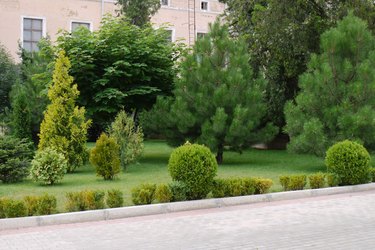
Growing a pine tree (Pinus spp.) from seed is relatively straightforward, especially if you sow the seed immediately after harvesting. Learn how to recognize ripe pine cones, prep seeds for planting and care for pine tree sprouts and seedlings.
Harvesting Pine Tree Seeds
Video of the Day
Pine cones are not pine tree seeds, but rather the "storage compartment" for dozens of seeds. Pine cones naturally crack open when the seeds are ready to harvest. This typically happens when they fall off the tree and sit in the heat of the sun.
Video of the Day
The University of Wisconsin notes that a dark brown or purplish color also indicates that a pine cone holds harvestable seeds. Avoid those that look green or yellow, or any that have already opened. You can start looking for suitable pine cones between July and November, depending on the pine species. Place them in a sunny location to encourage them to open naturally.
Once the pine cone has opened, shake out the seeds. The seeds have "wings" that can be removed if desired. Set up a box in front of a fan running on low speed and rub the seeds between your hands in front of the fan. The wings will blow away, and the seeds will drop back down to the box.
Germinating Pine Tree Seeds
There are many different types of "pine trees," and some have specific germination requirements. Some, such as the Jeffrey pine (Pinus jeffreyi, U.S. Department of Agriculture plant hardiness zones 5 through 7), have seeds that germinate immediately if sown when freshly harvested, according to the Fire Effects Information System.
Otherwise, the seeds become dormant and must be exposed to temperatures around 40 degrees Fahrenheit for 30 to 90 days (a process called "cold stratification") to initiate germination. Others, like the lodgepole pine (Pinus contorta var. latifolia, zones 3-7), have seeds covered in resin that won't germinate until the resin melts, which allows water to soften the seed coat as usual.
Assuming the seeds are freshly harvested, have undergone cold stratification or have otherwise been prepped for planting, germination is relatively straightforward. The seeds can be sown directly outdoors or started inside in a seed tray. An acidic, sandy loam is best for outdoor plantings, but indoor plantings should use a sterilized potting soil. Be sure to select a planting site in full sun.
Sow the seeds about 1 inch apart to a depth of about 1/2 inch and water thoroughly. Don't allow the seeds to dry out until the sprouts emerge, which can take 20 to 30 days. The seeds may return to dormancy if not kept adequately watered. If starting the seeds indoors, place in front of a south-facing window or under grow lights.
Caring for Pine Tree Seedlings
Once the seeds have germinated, start watering them only when the soil is dry. Pine trees started indoors can be transplanted outdoors after growing their second set of needles. Place them at least 8 inches apart if planting in rows. If you plan to transplant them again later, try to wait two to three years before doing so.
A disease known as "damping off" threatens the health of young pine tree seedlings. Consider applying a fungicide as a preventive measure. Or overplant the number of seeds and seedlings that you ultimately need, which will allow you to select the strongest and healthiest. Be sure to also keep weeds away from pine tree seedlings.